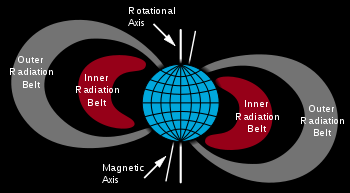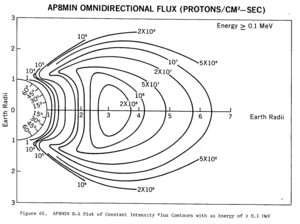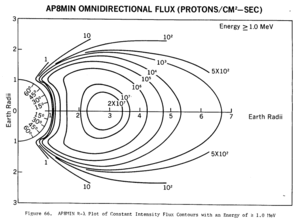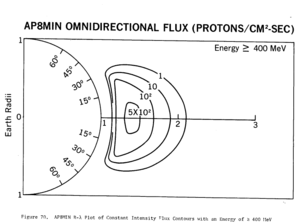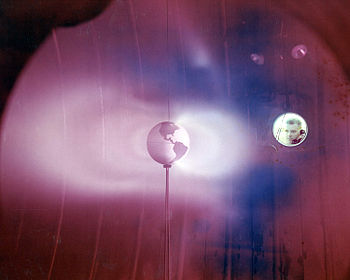- Van Allen radiation belt
-
The Van Allen radiation belt is a torus of energetic charged particles (plasma) around Earth, which is held in place by Earth's magnetic field. It is believed that most of the particles that form the belts come from solar wind, and other particles by cosmic rays.[1] It is named after its discoverer, James Van Allen, and is located in the inner region of the Earth's magnetosphere. It is split into two distinct belts, with energetic electrons forming the outer belt and a combination of protons and electrons forming the inner belts. In addition, the radiation belts contain lesser amounts of other nuclei, such as alpha particles. The belts pose a hazard to satellites, which must protect their sensitive components with adequate shielding if their orbit spends significant time in the radiation belts.
Contents
Discovery
Prior to the Space Age, the possibility of trapped charged particles had been investigated by Kristian Birkeland, Carl Stormer, and Nicholas Christofilos.[2] The existence of the belt was confirmed by the Explorer 1 and Explorer 3 missions in early 1958, under Dr. James Van Allen at the University of Iowa. The trapped radiation was first mapped out by Explorer 4, Pioneer 3 and Luna 1.
The term Van Allen belts refers specifically to the radiation belts surrounding Earth; however, similar radiation belts have been discovered around other planets. The Sun itself does not support long-term radiation belts, as it lacks a stable, global dipole field. The Earth's atmosphere limits the belts' particles to regions above 200–1,000 km,[3] while the belts do not extend past 7 Earth radii RE.[3] The belts are confined to an area which extends about 65°[3] from the celestial equator.
Research
An upcoming NASA mission, Radiation Belt Storm Probes (RBSP), will go further and gain scientific understanding (to the point of predictability) of how populations of relativistic electrons and ions in space form or change in response to changes in solar activity and the solar wind.
The RBSP mission is currently scheduled for 2012. The primary mission is scheduled to last 2 years, with expendables expected to last for 4 years. NASA's Goddard Space Flight Center manages the overall Living With a Star program of which RBSP is a project, along with Solar Dynamics Observatory (SDO). The Applied Physics Laboratory is responsible for the overall implementation and instrument management for RBSP.[4]
Van Allen radiation belts do exist on other planets in the solar system, whenever a planet or moon has a magnetic field that is powerful enough to sustain a radiation belt. However, many of these radiation belts have been poorly mapped. The Voyager Program (namely Voyager 2) only nominally confirmed the existence of similar belts on Uranus and Neptune.
Outer belt
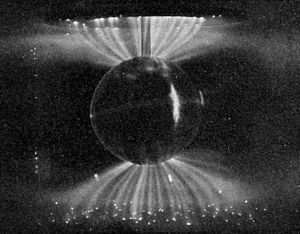 Laboratory simulation of the Van Allen belt's influence on the Solar Wind; these aurora-like Birkeland currents were created by the scientist Kristian Birkeland in his terrella, a magnetized anode globe in an evacuated chamber.
Laboratory simulation of the Van Allen belt's influence on the Solar Wind; these aurora-like Birkeland currents were created by the scientist Kristian Birkeland in his terrella, a magnetized anode globe in an evacuated chamber.
The large outer radiation belt extends from an altitude of about three to ten Earth radii (RE) or 13,000 to 60,000 kilometres above the Earth's surface. Its greatest intensity is usually around 4–5 RE. The outer electron radiation belt is mostly produced by the inward radial diffusion[5][6] and local acceleration[7] due to transfer of energy from whistler mode plasma waves to radiation belt electrons. Radiation belt electrons are also constantly removed by collisions with atmospheric neutrals,[7] losses to magnetopause, and the outward radial diffusion. The outer belt consists mainly of high energy (0.1–10 MeV) electrons trapped by the Earth's magnetosphere. The gyroradii for energetic protons would be large enough to bring them into contact with the Earth's atmosphere. The electrons here have a high flux and at the outer edge (close to the magnetopause), where geomagnetic field lines open into the geomagnetic "tail", fluxes of energetic electrons can drop to the low interplanetary levels within about 100 km (a decrease by a factor of 1,000).
The trapped particle population of the outer belt is varied, containing electrons and various ions. Most of the ions are in the form of energetic protons, but a certain percentage are alpha particles and O+ oxygen ions, similar to those in the ionosphere but much more energetic. This mixture of ions suggests that ring current particles probably come from more than one source.
The outer belt is larger than the inner belt and its particle population fluctuates widely. Energetic (radiation) particle fluxes can increase and decrease dramatically as a consequence of geomagnetic storms, which are themselves triggered by magnetic field and plasma disturbances produced by the Sun. The increases are due to storm-related injections and acceleration of particles from the tail of the magnetosphere.
There is debate as to whether the outer belt was discovered by the United States Explorer 4 or the USSR Sputnik 2/3.[citation needed]
Inner belt
The inner Van Allen Belt extends from an altitude of 100–10,000 km[8] (0.01 to 1.5 Earth radii) above the Earth's surface, and contains high concentrations of energetic protons with energies exceeding 100 MeV and electrons in the range of hundreds of keV, trapped by the strong (relative to the outer belts) magnetic fields in the region.
It is believed that protons of energies exceeding 50 MeV in the lower belts at lower altitudes are the result of the beta decay of neutrons created by cosmic ray collisions with nuclei of the upper atmosphere. The source of lower energy protons is believed to be proton diffusion due to changes in the magnetic field during geomagnetic storms.[9]
Due to the slight offset of the belts from Earth's geometric center, the inner Van Allen belt makes its closest approach to the surface at the South Atlantic Anomaly (SAA).[10]
Flux values
In the belts, at a given point, the flux of particles of a given energy decreases sharply with energy.
At the magnetic equator, electrons of energies exceeding 500 keV (resp. 5 MeV) have omnidirectional fluxes ranging from 1.2×106 (resp. 3.7×104) up to 9.4×109 (resp. 2×107) particles per square centimeter per second.
The proton belts contain protons with kinetic energies ranging from about 100 keV (which can penetrate 0.6 microns of lead) to over 400 MeV (which can penetrate 143 mm of lead).[11]
Most published flux values for the inner and outer belts may not show the maximum probable flux densities that are possible in the belts. There is a reason for this discrepancy: the flux density and the location of the peak flux is variable (depending primarily on solar activity), and the number of spacecraft with instruments observing the belt in real time has been limited. The Earth has not experienced a solar storm of Carrington event intensity and duration while spacecraft with the proper instruments have been available to observe the event.
Regardless of the differences of the flux levels in the Inner and Outer Van Allen belts, the beta radiation levels would be dangerous to humans if they were exposed for an extended period of time.[10][12]
- Flux values, normal solar conditions
Antimatter confinement
In 2011, a study has confirmed earlier speculation that the Van Allen belt could confine antiparticles. The PAMELA experiment detected orders of magnitude higher levels of antiprotons than are expected from normal particle decays while passing through the SAA. This suggests the van Allen belts confine a significant flux of antiprotons produced by the interaction of the Earth's upper atmosphere with cosmic rays.[13] The energy of the antiprotons has been measured in the range from 60 - 750 MeV.
Implications for space travel
Missions beyond low earth orbit leave the protection of the geomagnetic field, and transit the Van Allen belts. Thus they may need to be shielded against exposure to cosmic rays, Van Allen radiation, or solar flares. The region between two to four earth radii lies between the two radiation belts and is sometimes referred to as the "safe zone".[14][15]
Solar cells, integrated circuits, and sensors can be damaged by radiation. Geomagnetic storms occasionally damage electronic components on spacecraft. Miniaturization and digitization of electronics and logic circuits have made satellites more vulnerable to radiation, as the total charge in these circuits is now small enough so as to be comparable with the charge of incoming ions. Electronics on satellites must be hardened against radiation to operate reliably. The Hubble Space Telescope, among other satellites, often has its sensors turned off when passing through regions of intense radiation.[16] A satellite shielded by 3 mm of aluminium in an elliptic orbit (200 by 20,000 miles) passing through the radiation belts will receive about 2,500 rem (25 Sv) per year. Almost all radiation will be received while passing the inner belt.[17]
The Apollo astronauts traveled through the Van Allen radiation belts on the way to the moon; however, exposure was minimized by following a trajectory along the edge of the belts that avoided the strongest areas of radiation.[18] The total radiation exposure to astronauts was estimated to be much less than the five (5) rem set by the U.S. Atomic Energy Commission for people who work with radioactivity.[19]
Causes
It is generally understood that the inner and outer Van Allen belts result from different processes. The inner belt, consisting mainly of energetic protons, is the product of the decay of so-called "albedo" neutrons which are themselves the result of cosmic ray collisions in the upper atmosphere. The outer belt consists mainly of electrons. They are injected from the geomagnetic tail following geomagnetic storms, and are subsequently energized though wave-particle interactions. Particles are trapped in the Earth's magnetic field because it is basically a magnetic mirror. Particles gyrate around field lines and also move along field lines. As particles encounter regions of stronger magnetic field where field lines converge, their "longitudinal" velocity is slowed and can be reversed, reflecting the particle. This causes the particle to bounce back and forth between the Earth's poles, where the magnetic field increases.[20]
A gap between the inner and outer Van Allen belts, sometimes called safe zone or safe slot, is caused by the Very Low Frequency (VLF) waves which scatter particles in pitch angle which results in the gain of particles to the atmosphere. Solar outbursts can pump particles into the gap but they drain again in a matter of days. The radio waves were originally thought to be generated by turbulence in the radiation belts, but recent work by James Green of the NASA Goddard Space Flight Center comparing maps of lightning activity collected by the Micro Lab 1 spacecraft with data on radio waves in the radiation-belt gap from the IMAGE spacecraft suggests that they are actually generated by lightning within Earth's atmosphere. The radio waves they generate strike the ionosphere at the right angle to pass through it only at high latitudes, where the lower ends of the gap approach the upper atmosphere. These results are still under scientific debate.
There have been nuclear tests in space that have caused artificial radiation belts. Starfish Prime, a high altitude nuclear test, created an artificial radiation belt that damaged or destroyed as many as one third of the satellites in low earth orbit at the time.
Removal
The belts are a hazard for artificial satellites and are moderately dangerous for human beings, but are difficult and expensive to shield against.
The Russian physicist V.V. Danilov proposed the use of a High Voltage Orbiting Long Tether as a potential means to drain the radiation belt of high energy particles. The proposal involves deploying highly electrically charged tethers from satellites in orbit. Charged particles within the radiation belt encountering these tethers would be deflected by their large electrostatic fields onto paths that intersect with the atmosphere, where they would be harmlessly dissipated.[21] Simulations have suggested that the inner belt could be drained to 1% of its natural electron flux within two months of HiVOLT operation.[22]
See also
References
- ^ Van Allen Radiation Belts - HowStuffWorks - Discovery Communications - Retrieved 5 June 2011.
- ^ Stern, David P.; Peredo, Mauricio. "Trapped Radiation -- History". http://www-istp.gsfc.nasa.gov/Education/whtrap1.html. Retrieved 2009-04-28.
- ^ a b c Introduction to Geomagnetically Trapped Radiation by Martin Walt (1994).
- ^ "Construction Begins!". The Johns Hopkins University Applied Physics Laboratory. January 2010. http://rbsp.jhuapl.edu/newscenter/intheloop/2010_01.php.
- ^ Elkington, S. R.; Hudson, M. K.; Chan, A. A. (May 2001). "Enhanced Radial Diffusion of Outer Zone Electrons in an Asymmetric Geomagnetic Field". Spring Meeting 2001. American Geophysical Union. Bibcode 2001AGUSM..SM32C04E.
- ^ Shprits, Y. Y.; Thorne, R. M. (2004). "Time dependent radial diffusion modeling of relativistic electrons with realistic loss rates". Geophysical Research Letters 31 (8): L08805. Bibcode 2004GeoRL..3108805S. doi:10.1029/2004GL019591.
- ^ a b Horne, Richard B.; Thorne, Richard M. et al (2005). "Wave acceleration of electrons in the Van Allen radiation belts". Nature 437 (7056): 227–230. Bibcode 2005Natur.437..227H. doi:10.1038/nature03939. PMID 16148927.
- ^ ECSS Space engineering ECSS-E-ST-10-04C 15 November 2008
- ^ Tascione, Thomas F. (1994). Introduction to the Space Environment, 2nd. Ed.. Malabar, Florida USA: Kreiger Publishing CO.. ISBN 0-89464-044-5.
- ^ a b NASA Goddard Spaceflight Center, The Van Allen Belts (Accessed May 25, 2011)
- ^ Hess, Wilmot N. (1968). The Radiation Belt and Magnetosphere. Blaisdell Pub. Co..
- ^ Jerry L. Modisette, Manuel D. Lopez, and Joseph W. Snyder, "Radiation Plan for the Apollo Lunar Mission". AIAA paper 69-19 (accessed May 25, 2011).
- ^ Adriani, O. (25 Jul 2011). "The discovery of geomagnetically trapped cosmic ray antiprotons". Astrophysical Journal Letters 737 (2). arXiv:1107.4882. Bibcode 2011ApJ...736L...1H. doi:10.1088/2041-8205/736/1/L1.
- ^ "Earth's Radiation Belts with Safe Zone Orbit". Goddard Space Flight Center, NASA. http://svs.gsfc.nasa.gov/vis/a000000/a003000/a003052/index.html. Retrieved 2009-04-27.
- ^ Weintraub, Rachel A.. "Earth's Safe Zone Became Hot Zone During Legendary Solar Storms". Goddard Space Flight Center, NASA. http://www.nasa.gov/vision/universe/solarsystem/safe_zone.html. Retrieved 2009-04-27.
- ^ "Hubble Achieves Milestone: 100,000th Exposure". STScI. 1996-07-18. http://hubblesite.org/newscenter/archive/releases/1996/25/text/. Retrieved 2009-01-25.
- ^ Ptak, Andy (1997). "Ask an Astrophysicist". NASA GSFC. http://imagine.gsfc.nasa.gov/docs/ask_astro/answers/970228a.html. Retrieved 2006-06-11.
- ^ "The Moon Hoax Debate". Robert A. Braeunig. http://www.braeunig.us/space/hoax.htm. Retrieved 2011-06-13.
- ^ "Biomedical Results of Apollo". NASA. http://lsda.jsc.nasa.gov/books/apollo/S2ch3.htm. Retrieved 2011-06-13.
- ^ NASA/GSFC, The Exploration of the Earth's Magnetosphere, An educational web site by David P. Stern and Mauricio Peredo.
- ^ David, L. (2002-09-16). "Proposal: Removing Earth's Radiation Belts". Space.com. http://www.space.com/scienceastronomy/radiation_belts_020916.html. Retrieved 2010-03-09.
- ^ "High-Voltage Orbiting Long Tether (HiVOLT): A System for Remediation of the Van Allen Radiation Belts". Tethers Unlimited. http://www.tethers.com/HiVOLT.html. Retrieved 2010-03-09.
- Holmes-Siedle, A. G. and Adams, L (2002), Handbook of Radiation Effects (Oxford University Press, England 2002). ISBN 0-19-850733-X.
- Adams, L., Harboe Sorensen, R., Holmes Siedle, A. G., Ward, A. K. and Bull, R. (1991), "Measurement of SEU and total dose in geostationary orbit under normal and solar flare conditions," IEEE Transactions on Nuclear Science, NS 38 (6), pp. 1686–92 (Dec 1991)
- Shprits, Y. Y., S. R. Elkington, N. P. Meredith, and D. A. Subbotin (2008), "Review of modeling of losses and sources of relativistic electrons in the outer radiation belts," J. Atmos. Sol. Terr. Phys., 70: Part I, Radial transport, pp. 1679–1693, doi:10.1016/j.jastp.2008.06.008; Part II. Local acceleration and loss, pp. 1694–1713, doi:10.1016/j.jastp.2008.06.014.
External links
- An explanation of the belts
- Trapped particle radiation models—Introduction to the Trapped Radiation Belts.
- SPENVIS - Space Environment, Effects, and Education System—Gateway to the SPENVIS orbital dose calculation software.
- D. P. Stern, M. Peredo (2004-09-28). "The Exploration of the Earth's Magnetosphere". NASA. http://www-istp.gsfc.nasa.gov/Education/Intro.html. Retrieved 2006-08-22.
- NASA Radiation Belt Storm Probe Mission
Magnetospherics Submagnetosphere Earth's magnetosphere Solar wind Satellites Research projects Other magnetospheres Related topics Categories:- Geomagnetism
- Space plasmas
Wikimedia Foundation. 2010.

